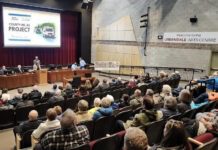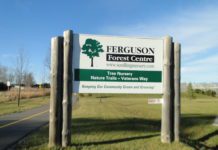A transport trailer just inside a gate, south of Bishops Mills, contains tens of thousands of specimens of flora and fauna, both local and from all across Canada. Fred Schueler and Aleta Karstad have been housing the specimens in the trailer since 2014, when they moved them out of the Bishops Mills Natural History Centre, which had been located in the old general store building. Many of the collections and most of the shelving and cabinets are from the Eastern Ontario Biodiversity Museum that was in the basement of Raina’s Mall on Sanders Street from 1997-2005.
Last week, Algonquin Towing made a valiant attempt to move the trailer to a site closer to Fred and Aleta’s home in Bishops Mills so they could more easily access the collection for curation and inventory, with the aim that it can be sent to natural history museums across the continent. In a perfect world, they would love to see a natural history museum established in North Grenville. “If we had a municipal museum, we would have everything to equip it,” Fred says. “We consider ourselves holders of the collection that can be used by other museums.”
When the heavy-duty tow truck tried to get the trailer moving, it was discovered that six years of rust prevented the wheels from turning. Algonquin Towing and Fred and Aleta’s resourceful neighbour, Kevin Willey, are still working on the problem.
Eventually, Fred and Aleta would love to attract some volunteers who are interested in working with specimens to help them sort through the collection. According to Aleta, it is important to preserve specimens, since they are physical evidence of life on Earth. Most of these specimens were gathered by Fred and Aleta in the decades between 1990 and 2010, when natural history museums had largely stopped adding to their collections. This is when many native freshwater mussels were being wiped out by Zebra Mussels, so their collections document many extinct populations.
“Natural history collections are a marker in time of species, and we never know how they are going to be needed in the future, or how they are going to be used. Fred didn’t know that he was preserving DNA when he collected the leopard frog specimens for his thesis as skins,” Aleta says, “but it turned out he had, and, in 2001, this allowed understanding of the genetic variation of the species throughout its range, including areas in Ontario and British Columbia, where the populations are now extinct.”
If you are interested in working with specimens and helping Aleta and Fred with inventory, you can email them at karstad@pinicola.ca or bckcdb@istar.ca.





